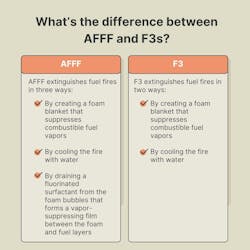What's The Difference Between AFFF and F3s
The use of Aqueous Film Forming Foam (AFFF) containing PFAS in firefighting, particularly for aircraft fires, has been a subject of growing concern due to the potential health and environmental impacts of PFAS exposure. The chemicals in PFAS are persistent in the environment and have been linked to various health issues, including cancer, thyroid disease, liver damage, and reproductive and developmental problems. As a result, there is a push to transition to fluorine-free foam (F3) as an alternative to AFFF.
Background on AFFF and F3s
The Federal Aviation Administration (FAA) and the Department of Defense (DoD) have recognized the importance of finding safer alternatives to PFAS-containing firefighting foam and have been actively researching and testing F3 foams. These efforts aim to find a foam that is as effective as AFFF in firefighting, particularly in situations involving aircraft fires, but without the negative health and environmental consequences associated with PFAS.
In response to these concerns, Congress directed the FAA to create a transition plan for the orderly move to MILSPEC F3 foams for aircraft firefighting. This plan involves phasing out the use of AFFF and implementing fluorine-free alternatives while ensuring that firefighting capabilities and safety standards remain high. The transition plan will involve evaluating available F3 foams, conducting tests to ensure their effectiveness and compatibility with current firefighting systems, and working with airports and other stakeholders to facilitate the transition.
F3 Products Implementation Policy & Guidance Timeline According to the FAA
· Jan. 6, 2023: The US Navy published a new MilSpec outlining the performance requirements F3s must meet to be certified and listed on the Navy’s Qualified Products List (QPL).
· Jan. 12, 2023: FAA stated it will accept the use of F3s listed on the Navy’s QPL for aircraft rescue & firefighting (ARFF) purposes at Part 139 airports as an alternative to legacy aqueous film forming foams (AFFFs).
· September 13, 2023: The Navy was required by Congress to have products approved and listed on the QPL by October 1, 2023.
· Once F3s are posted to the QPL, civil airports can begin their transition to these new foams.
The U.S. Environmental Protection Agency (EPA) released an updated "Interim Guidance on the Destruction of Perfluoroalkyl and Polyfluoroalkyl Substances and Materials Containing Perfluoroalkyl and Polyfluoroalkyl Substances" (PFAS) on Tuesday, April 9, 2024. This updated guidance provides decision-makers with the latest scientific information on evaluating the most appropriate destruction, disposal, or storage methods for PFAS wastes.
Key points from the updated guidance include:
- Prioritization of technologies that minimize environmental release to better protect public health.
- A new technology evaluation framework to assess the latest destruction and disposal methods.
- Emphasis on generating and publicly sharing data to evaluate the feasibility of existing and new technologies on a larger scale.
The guidance allows government officials and private industry to make informed decisions on PFAS disposal and destruction, reflecting the Biden-Harris Administration's commitment to advancing scientific understanding in this area.
The updated guidance retains the 2020 guidance's focus on three existing technologies: underground injection, landfills, and thermal treatment. It also incorporates public comments on the 2020 guidance and years of research and development of new technologies for PFAS disposal.
This interim guidance is part of the EPA's PFAS Strategic Roadmap and includes a 180-day comment period following its publication in the Federal Register.
The Difference Between AFFF and F3s
The FAA is guiding the transition from Aqueous Film Forming Foam (AFFF) containing PFAS to fluorine-free foam (F3) products in firefighting operations, particularly in aircraft firefighting at Part 139 airports. The differences between AFFF and F3 are significant and have implications for firefighting techniques and safety.
AFFF (Aqueous Film Forming Foam):
- Triple Action: AFFF extinguishes fuel fires in three ways:
- By creating a foam blanket that suppresses combustible fuel vapors.
- By cooling the fire with water.
- By draining a fluorinated surfactant from the foam bubbles that forms a vapor-suppressing film between the foam and fuel layers.
- Vapor-Suppressing Film: The film helps the foam blanket travel across fuel spills and reseal itself if the blanket breaks down, providing ongoing vapor suppression.
F3 (Fluorine-Free Foam):
- Double Action: F3 extinguishes fuel fires in two ways:
- By creating a foam blanket that suppresses combustible fuel vapors.
- By cooling the fire with water.
- No Vapor-Suppressing Film: F3 lacks the film-forming properties of AFFF, so the foam blanket must be carefully maintained to suppress fires effectively. If the foam blanket is disturbed, it lacks resealing properties.
Considerations for Transition to F3
- Foam Blanket Management: Effective foam blanket management is critical with F3. A poor-quality foam blanket can lead to reigniting fuel spills, creating a hazardous situation for firefighters.
- Training and Awareness: Proper training and awareness of the condition of the foam blanket are crucial when using F3. This includes the use of spotters and backup handline crews.
- Compatibility and Mixing: MILSPEC F3 products cannot be mixed with other types of MILSPEC F3 products. Airports should be careful when choosing F3 products to avoid compatibility issues.
Impact on Airports
- Transition to F3: While the FAA does not currently require airports to transition to F3, the adoption of the MILSPEC (Military Specification) will make F3 an acceptable means of complying with Part 139 regulations.
- Financial Assistance: The FAA has not yet decided on providing financial assistance to airports for transitioning to F3 and disposing of AFFF.
- Local Requirements: Airports should check with state and local municipalities for any specific requirements regarding the use of F3 or AFFF.
The FAA's guidance and training emphasize the importance of proper training and techniques when using F3 to ensure effective and safe firefighting operations.
About the Author
Christina Marsh
Editor
Christina Marsh (Basken) is a passionate aviation enthusiast and sport pilot with industry knowledge and experience in writing and editing for digital and print publications as well as creative content in photography, videography, and podcasting.
Christina graduated from the University of Wisconsin-Oshkosh with a bachelor’s degree in journalism with a visual emphasis.

